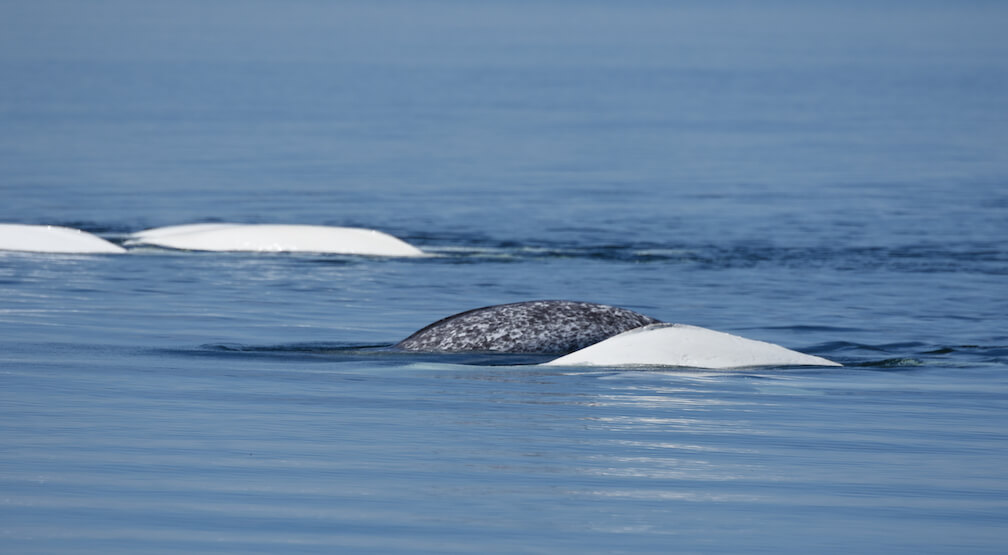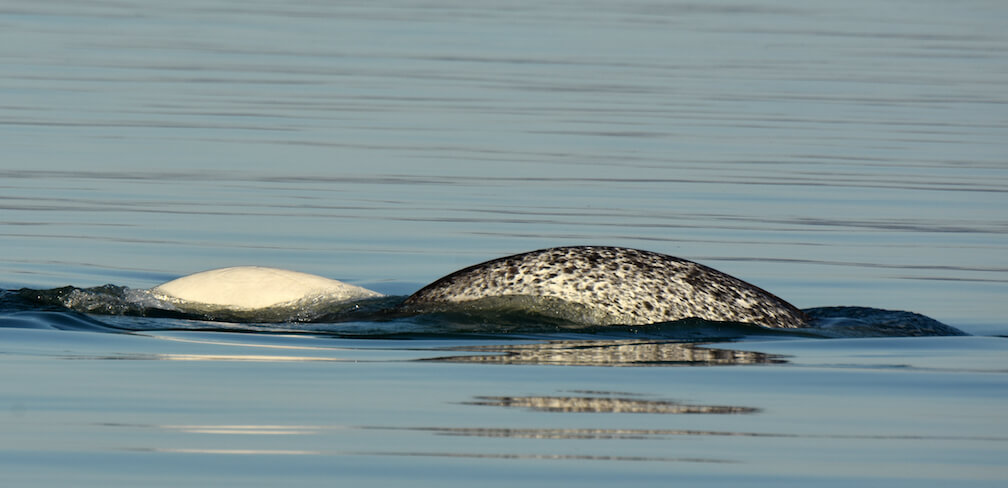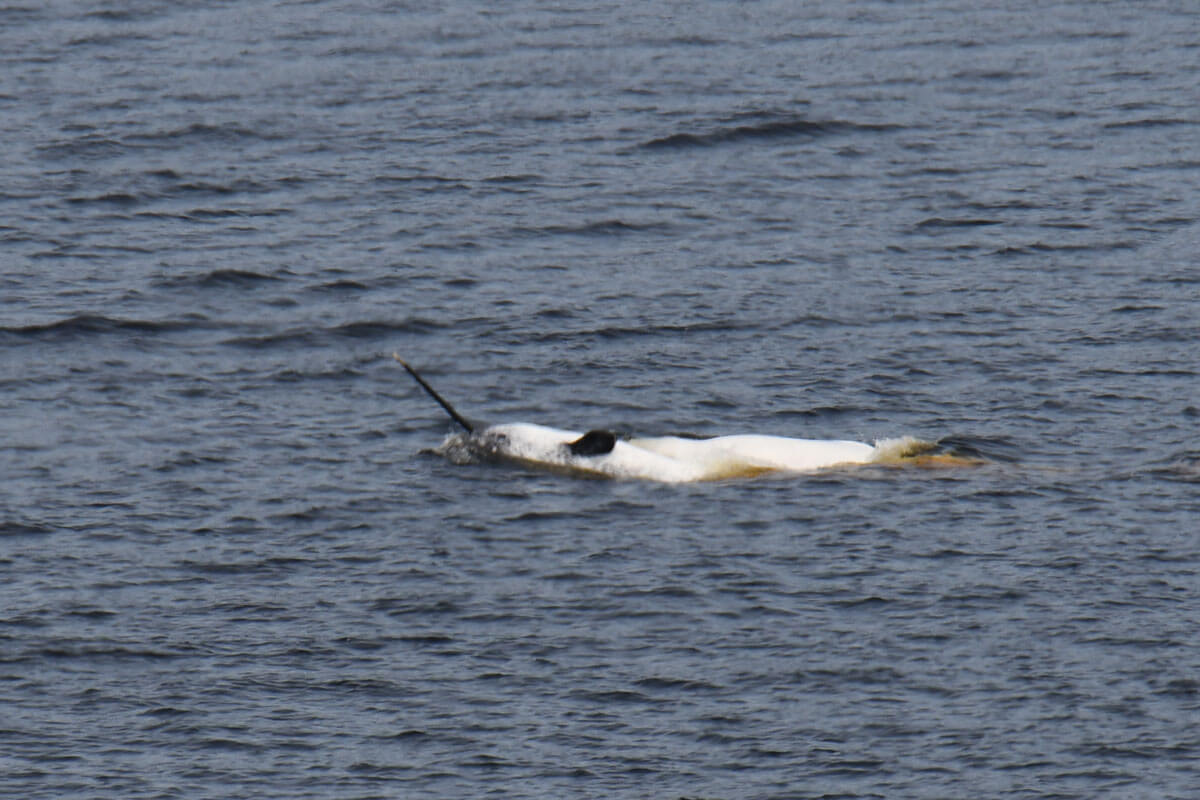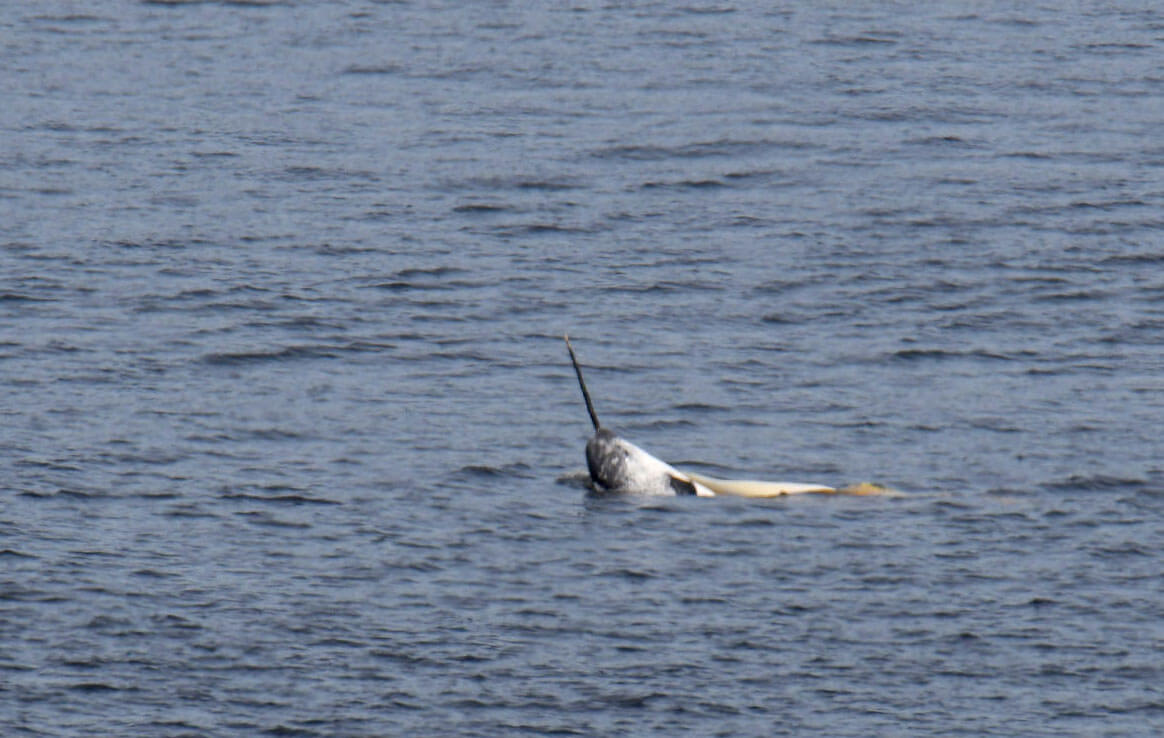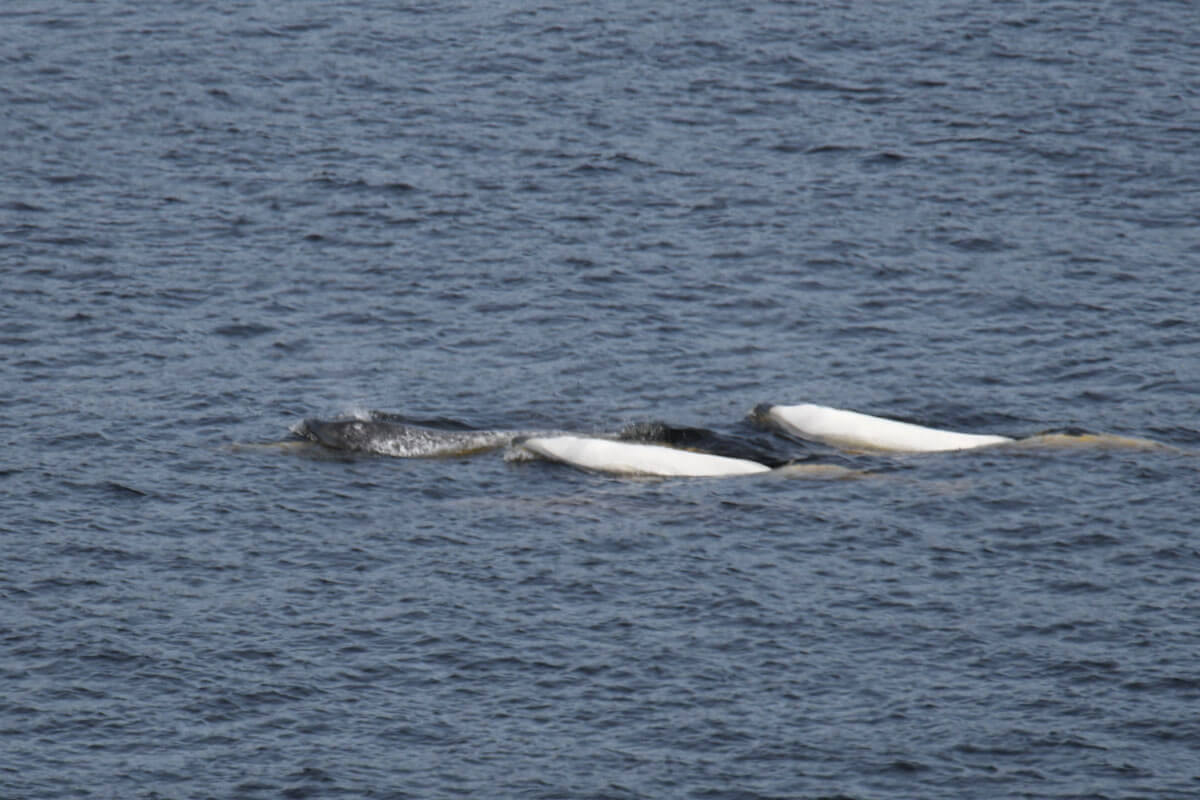Narwhal (Nordet)
Narwhal

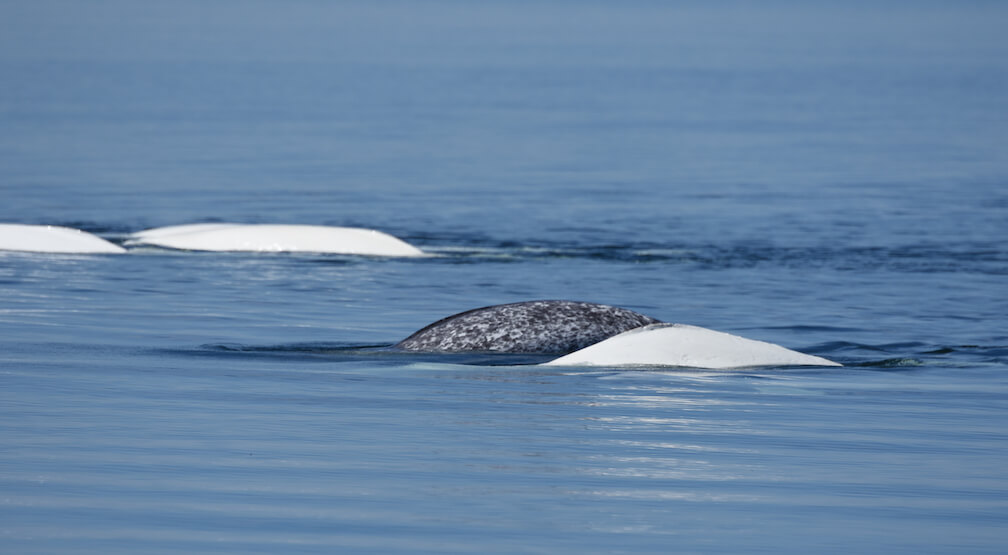
Adopted by collective sponsors
-
ID number
Unknown
-
Sex
Male
-
Year of birth
Unknown
-
Known Since
2016
Distinctive traits
The narwhal is distinguished by its dark speckled colouration that contrasts with the almost uniform white colouring of the belugas with which it is found. Another difference compared to belugas is its “tusk”, which is in fact a clearly visible left incisor.
Life history
The narwhal now has a unique name: Nordet. Like the wind coming from the northeast, Nordet has brought a breath of fresh air to the St. Lawrence since his arrival in 2016.
Since 2016, this juvenile male narwhal has been swimming together with St. Lawrence belugas. Native to the Arctic, over 1,000 km from the St. Lawrence, this animal is far from its natural habitat. Did it lose its way? Was it fleeing a predator for too long and unable to find its way back home? Was it following prey? Or, is it simply adventurous by nature? In any case, the narwhal seems to have found a welcoming community with the belugas in the St. Lawrence. Whenever it is sighted, it is always swimming in the company of these white whales. You want to follow its adventure? Adopt him!
Adopt the narwhal!
Contribute to scientific research on whales by making a donation.

Sponsors
Maïa Arseneault
Corno, as in the italian word unicorno (unicorn)
Marine Baillie
D’Artagnan, as suggested by many, would fit naturally
Julie Beaurivage
I suggest D’Artagnan
Catherine Boily
I’d like to suggest Imagine
Demain Demain Inc.
We are very proud to be closing the collective adoption of the narwhal thanks to the funds raised with the participation of our clients for the purchase of our Beluga bag. We really like Tugalik [narwhal in Inuktitut] as a name for the narwhal. Long live this beautiful project!
Élian Dinel
Sérénité
Chloé Fournier
Sofi Plamondon, writer
Narvala
Marie-Frédérique Frigon
Sybil,the narwhal among belugas, like the famous American patient with multiple personality disorder.
Jeanne et Simone Garneau Nadon
Nathalie Gauthier
Julie Hins
long live to Excalibur
Jenny Lapointe
My husband and I love narwhals! We affectionately named Marcellin, the narwhal among the belugas!
Catherine Laratte
“Narwhal” in inuktitut
Mathilde and Clémence Marcil
We suggest Arcane – synonym of mysteries and magic. We dream of having the privilege to see Arcane in our waters!
Alex Martin
D’Artagnan!
Palmers Family
Great name choices! We really like d’Artagnan. We also suggest Piqati, “friend” in one of the Inuktitut dialects (in the same vein, Kigut is very charming). We are very happy to participate as a family in this collective adoption!
Marie-Lyne Pelletier
I am honored to be part of the godparents of the narwhal. ![]() As a name, I suggest “Pana” which means sword in Inuktitut. Congratulations on your beautiful work!
As a name, I suggest “Pana” which means sword in Inuktitut. Congratulations on your beautiful work!
Perreault-Shniper-Delanghe-Morton Family
Tugalik, which means Narwhal in Inuktitut – or Kigut (tooth in Inuktitut)
Monia Pouzet
Narvy
Alexandre St-Germain Lapointe
Claudiu Suciu
I suggest Tugalik.
Marie Poulin
Pinocchio, adventurous and reckless like the puppet in the story, one had a big nose and the other a big tooth
Mathilde Legault
Louis Félix Coydon
Name suggested by my son who adores narwhals since childhood: Mėgalodon because it means “big tooth”. We tried to spot it in 2019 on the shores of the Paradis marin among a dozen belugas. It was wonderful!
Noémie Boivin
Marie-Eve Desnoyers
Cathy Faucher, illustrator and author
It is a pleasure for me to put my art to the benefit of the protection of the whales of the St-Lawrence. I suggest Nordet as a name, like the wind that comes from the north. This narwhal takes us by surprise like the wind. It is my pleasure to make a donation in his honor. He brings a new breath to the St. Lawrence beluga community. Let’s salute this living together!
Marie-Philip Dufour
Alexandre Paradis-Michaud
Cynthia Price
Linnaeus – Carl Linnaeus originally described the species in 1758. This donation is being made in recognition of Marie-Ève Muller’s work with the GREMM, her great relationship with the summer community and her love for the whales!
Mylie Chong
I suggest Kigut (tooth in inuktitut)
Théodore-Archibald Rivard Laurent
Paula Maranon
I suggest Jet le Narval
Marwan Valois
I am 6 years old and I would like the narwhal to be called Arc-en-ciel (Rainbow) because they both make me very happy and put happiness in my heart.
Nathalie Paquette
Phil for philanthropy! Very excited about this unique adoption!
Emily Beauchamp
I suggest the name Nordet 
Narwhals and belugas: cold-water cousins
The narwhal and the beluga are the only two species in the family Monodontidae, a suborder of toothedwhales. These two species inhabit arctic and subarctic regions and have a circumpolar distribution, meaning they are found all around the North Pole. Being closely related, belugas and narwhals share certain characteristic traits such as the absence of a dorsal fin on their back. Instead, they have a dorsal ridge, which may be an adaptation to life in cold water. In fact, in most cetaceans, the blubber-less dorsal fin is known to be used to evacuate heat. In Monodontidae species, the smaller and stronger dorsal ridge is believed to be used notably to break through the ice in order to reach the surface.
Measuring between 3.95 m and 5.5 m, adult narwhals are about the same size as belugas. Additionally, males feature a long protruding tooth, which can add up to 3 m!
As with belugas, narwhals’ colouring changes over time. The skin turns paler with age and the speckled spots on the back change over time.
Both belugas and narwhals are gregarious and highly social, meaning they are most often seen in groups. For these two species, females experience menopause and grandmothers are believed to play a role in caring for young and transferring knowledge.
Despite their similarities and overlapping ranges, narwhals and belugas are not typically seen together. Researcher Marianne Marcoux, narwhal specialist at Fisheries and Oceans Canada says: “I once observed a beluga swimming amongst a group of narwhals in Eclipse Sound (Translator’s note: now known as Tasiujaq).Belugas and narwhals have been seen together during their spring migration in Navy Board Inlet, but these encounters are believed to be of short duration. One of the few places in Canada where the respective ranges of narwhals and belugas overlap is in northwest Hudson Bay. Narwhals and belugas share the same waters, but don’t necessarily intermingle.” Thus, the two species are not frequently seen together.
Can the narwhal communicate with belugas?
It is quite possible that the narwhal will come to understand the belugas and to make itself understood. Researcher Valeria Vergara, affiliated with Ocean Wise and collaborator for the Group for Research and Education on Marine Mammals (GREMM), is an expert in beluga communication. “I have little doubt that narwhals and belugas can communicate well with each other. The only published paper about narwhal contact calls indicates that they produce very similar contact calls as belugas do. The author [Ari Shapiro] sent me audio clips of his two tagged narwhal, and I was able to verify by ear that at least their contact calls are very similar to the contact calls produced by belugas,” she explains.
Contact calls are an element of communication that are believed to be used to identify the individual producing the sound, much like when we introduce ourselves before speaking into a walkie-talkie.
Valeria Vergara adds, “I know from chatting with other researchers that work with recordings in areas that are frequented by both species that it is often difficult to tell both species apart acoustically. This is not surprising, given their close taxonomic relationship and the fact that they have evolved in similar environments.” Will marine mammal communication specialists in the St. Lawrence such as Valeria Vergara or Yvan Simard from Fisheries and Oceans Canada recognize the narwhal in the recordings made here? Stay tuned!
Were any researchers familiar with this narwhal when it was still in the Arctic?
Narwhal photo-ID projects are rare. As part of a study carried out in the Arctic, researchers Marianne Marcoux (Fisheries and Oceans Canada) and Marie Auger-Méthé (Dalhousie University) relied on notches in the animals’ dorsal ridge to differentiate them. Indeed, the colour pattern in narwhals changes over the years – unlike blue whales, for example, whose speckled mosaics are permanent. However, the two researchers have not been able to identify the St. Lawrence narwhal amongst those featured in their catalogue.
A horn? A tooth? A tusk?
No, it’s not a unicorn horn, but rather a tooth growing through the narwhal’s upper lip! The species’ scientific name, Monodon monoceros, can be translated as “one tooth, one horn”. Narwhals usually have just two teeth, one of which is twisted in shape and can grow up to 3 m long in adult males. Rarely, some narwhals will show both teeth protruding out of their lip, with one often being shorter than the other. This characteristic tooth or tusk is found in males and occasionally in females. At the Marine Mammal Interpretation Centre, visitors can observe and touch a narwhal tusk measuring 176 cm long and weighing nearly 7 kg.
“Our” narwhal still has a relatively small tusk, a sign that it has not yet reached sexual maturity. Nevertheless, its tusk has gotten longer since 2016 and continues to grow every year.
What is the purpose of this tusk?
Assumptions vary and it is possible that it performs multiple functions. Analysis of narwhal teeth has shown that they contain millions of nerve endings, which might allow the animal to sense water pressure, salinity and temperature, or perhaps even to detect prey. In a very dark, often ice-covered environment, the tusk might therefore serve as a sort of “flashlight”, allowing the animal to locate holes in the pack ice where it can surface to breathe.
On one occasion in 2017, researchers were able to film narwhals stunning prey with their tusks. This behaviour had previously been reported by Inuit, but had never been documented. However, it is not known how common such a hunting technique might be.
The tusk may also be a highly valued attribute by females and thereby play a role in determining which males get to reproduce.
Marks and scars in males suggest that the tusk may also be used in sparring. However, no researcher has ever documented such fighting and even the Inuit do not seem to have ever witnessed such displays of combat. However, it should be noted that observations in the Arctic are complicated by ice and darkness for much of the year. Young males are often seen clashing tusks during the summer months. Is this their way of showing off their fighting spirit? A means of communication?
There are still many mysteries surrounding the famous tusk of this “unicorn of the sea”.
Could the narwhal potentially mate with a beluga?
Indeed, a Danish research team was able to confirm in 2019 that at least one narwhal-beluga hybrid has lived to adulthood. Published in Scientific Reports, this study was even able to demonstrate–through an analysis of DNA taken from the skull–that the male offspring was born to a female narwhal and a male beluga.
The story behind this discovery begins in 1990, when a Danish scientist noticed a strange skull on the roof of an Inuk man’s home in western Greenland. The shape of the skull resembles that of a beluga or narwhal, but not the dentition. The teeth are more numerous than those of the narwhal but less than those of the beluga; further, they are more angled and some of them are twisted like the left canine of the narwhal. The Inuk held on to this skull, but during his subsistence hunt he observed two other individuals similar to the one the skull belonged to. According to the description provided to the researcher, the whale was grey, of adult size, and had no dorsal fin, pectorals similar to those of a beluga and a narwhal-like tail. The researcher takes the skull back to the Natural History Museum of Denmark at the University of Copenhagen, where it remains to this day. Then, in 2019, researchers finally have access to the technology they need to confirm the hybrid hypothesis. Using stable isotopes, they are also able to study the animal’s diet, which differs from that of narwhals and belugas in its region. Why so? Possibly because of its odd teeth, it was better able to search for prey on the seabed. Despite its singularity, the whale was able to survive to adulthood.
Let’s return to the St. Lawrence. Here, the narwhal present amongst the belugas is a male, unlike the aforementioned case in Greenland. Is hybridization possible in this direction? At the present time, the narwhal has probably not yet reached sexual maturity. This will occur around the age of 11 to 13 years, a few years later than in females. Will female belugas be interested in him then? Is he fertile? Will interbreeding be possible? To be continued!
Narwhal at risk or not?
The status of the narwhal is considered to be “of concern” by the Committee on the Status of Endangered Wildlife in Canada (COSEWIC). Accelerating climate change is disrupting their habitat and the distribution of their prey, in addition to increasing shipping traffic in a region that until quite recently was rather quiet. For the estimated 160,000 narwhals in Canada, mitigating climate change is essential to preserving the quality of their habitat.
On the other hand, even if the narwhal is not endangered in the St. Lawrence, “our” individual is currently being observed with belugas which, in turn, represent an endangered population. So, regardless of where you are in the Estuary, a minimum distance of 400 metres should be maintained with belugas and, in turn, the narwhal.
Observations history in the Estuary
Years in which the animal was not observed Years in which the animal was observed
Latest news from Portrait de baleines
The St. Lawrence narwhal has been seen for a sixth consecutive year! Its presence was confirmed for the first time this summer in mid-July, off Basque Island. Since then, it has been observed at least four times. This mysterious narwhal seems to have truly made the St. Lawrence beluga population its own. Until now, it has been observed mainly in large herds of juveniles. Lately, thanks to the capture of images by drones, we have been able to see him interacting with his fellow belugas. Among other things, he was performing and receiving pelvic projections, a common sexual social behavior between young adults. Is this a sign that he is well integrated into the beluga society? It is hard to say, since the composition and function of the herds of young adults are still unknown to researchers. Could these herds of juveniles be a “beluga whale nursery”, a place where males who have left their maternal community prepare themselves for adult life? In fact, the story of this young narwhal could tell us a lot about the social life of belugas. Thanks to its speckled skin and its tusk, it can easily be distinguished from its new companions. It can therefore serve as a reference point and a comparison when studying the behaviour of the belugas in its group.
On August 4, a speckled back contrasts with the white backs of belugas swimming below the Pointe-Noire land observation platform in Baie-Sainte-Catherine. Laurence Tremblay, a research assistant of the Group for Research and Education on Marine Mammals (GREMM), aims her camera lens at the group. Thanks to her focus, she manages to snap the narwhal’s picture!
Belugas and narwhal are stirring near the surface. Their bodies brush against each other, almost jostling one another. The narwhal’s twisted left canine rises into the air. In an adult narwhal, this tooth can reach a very respectable 2.5 metres long! But the narwhal that has been swimming in the St. Lawrence since 2016 does not yet boast such a large tusk.
Belugas pound the narwhal using a behaviour known as “pelvic thrusting”. Is this their way of practising for breeding? A sort of “handshake” amongst members of the same clan? A movement that is simply pleasant to perform? This is the kind of not-so-straightforward question that interests GREMM’s research team.
On August 5, the narwhal was seen in Baie-Sainte-Marguerite, Sacré-Coeur.
The narwhal has been identified again this year on several occasions. It does not have a code, as it is the first of its kind to have been photo-identified in the Estuary. The narwhal is distinguished by its dark speckled colouration that contrasts with the almost uniform white colouring of the belugas with which it is found. Another difference compared to belugas is its “tusk”, which is in fact a clearly visible left incisor. Still relatively short, this tooth does not often emerge out of the water. The size of the tooth indicates that it is probably a juvenile. Research assistants employed by GREMM compared photos of both flanks of the individual observed this year with photos taken the previous two years. As the narwhal’s colouration evolves from year to year, it is generally the notches in its dorsal ridge that make it possible to identify it. In the case of this individual, the spots near the neck and around the ridge were still present and confirmed that this is indeed the same narwhal observed since 2016. For the time being, we have not yet determined whether or not the narwhal is being seen with the same belugas each year or at every sighting.
The narwhal and the beluga are the only two species that belong to the family Monodontidae, a suborder of toothed whales. The narwhal has just one tooth that grows in a spiral and can measure up to 300 cm in adult males. This diagnostic tooth is found in males and occasionally in females. At the Marine Mammal Interpretation Centre, visitors can observe and touch a narwhal tooth measuring 176 cm long and weighing nearly 7 kg. Narwhals and their beluga cousins share a few characteristic traits. These two species live in the Arctic and subarctic regions and have a circumpolar distribution, i.e. all around the North Pole. They are characterized by the lack of dorsal fin on their back; instead, they have a dorsal ridge, which may be an adaptation to life in cold water. In fact, the dorsal fin in cetaceans, which is devoid of blubber, is known to be used to evacuate heat. In Monodontidae species, the dorsal ridge is believed to be used notably to break the ice in order to reach the surface.
Highly social and gregarious animals, belugas and narwhals are most often seen in groups. To date, no beluga-narwhal hybrid has ever been confirmed. In the late 1980s, a skull discovered in western Greenland belonging to a toothed whale raised hypotheses in the community, but no definitive conclusion could be drawn.
For this issue, we push the boundaries of the typical Whale Portraits content on the occasion of the confirmed presence of a special visitor: the stray narwhal spotted last summer is back in the Marine Park! It was by complete chance that the animal was photographed last August 20 off Pointe-Noire. Our research assistant had taken a few shots of a herd of about six belugas passing by, and he was examining his photos when his colleague on board also noticed an animal that stood out with its dark, speckled mantle. The doubts were quickly dispelled: it was indeed a narwhal!
Narwhal photo-ID projects are rare. In an Arctic study, researchers Marianne Marcoux (Fisheries and Oceans Canada) and Marie Auger-Méthé (Dalhousie University) relied on notches in the animals’ dorsal crests to differentiate them, as colour patterns in narwhals evolve over the years – unlike blue whales for example, whose speckled mosaics are permanent.
Getting back to our exceptional visitor, we had to scrutinize its pigmentation pattern to validate that it was the same individual as the one documented last year: the distinctive marks around the animal’s head and neck were used as a reference, as they have remained unchanged over the past year. “We do not have a catalogue of narwhals, despite the fact that they are abundant in Canada (150,000). Furthermore, narwhals do not exhibit much genetic diversity, so it is not possible to use genetics to determine where this narwhal comes from,” says Marcoux.

“It will take other series of photographs to ensure monitoring of the animal over the long-term”, adds GREMM Scientific Director Robert Michaud. It should be noted that, although it might be tempting to go take a peek at our special guest, the latter seems to have been adopted by a group of belugas. This means that no breach of regulations can be justified by the presence of the narwhal. The minimum distance of 400 m between boats and belugas – even if accompanied by the narwhal – remains in force. Thank you for helping to protect this endangered population!
To dive deeper
Narwhal still present in the St. Lawrence (Whales Online 2020/08/05)
With the Belugas… their newborns and the narwhal (Whales Online, 2019/10/24)
Menopause in Belugas and Narwhals (Whales Online 2018/08/27)
With the belugas… and a narwhal! (Whales Online 2018/07/19)
Beluga whales adopt lost narwhal in St. Lawrence River (CBC, 2018)
Belugas adopt a stray narwhal (AJ+, 2018)


